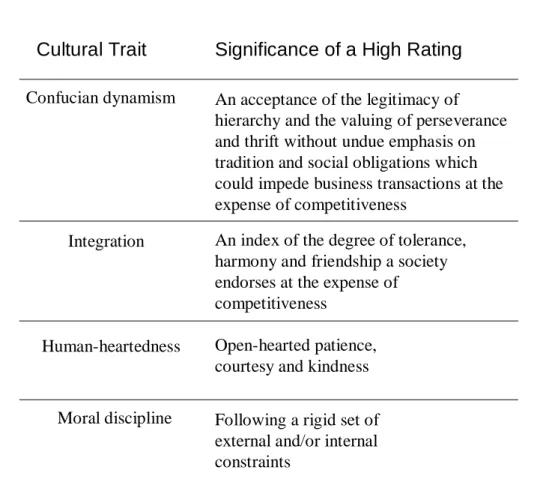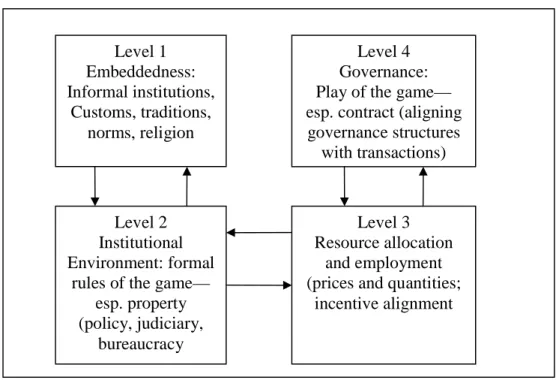CHAPTER II. LITERATURE REVIEW
Culture 2.1 The Evolution of Culture
Informal rules of behavior which Denzau and North (1994) designate as institutions are studied by many as the factors that influence personal decisions and the decisions of the organization. It is necessary to study the organization because it is dependent on the entrepreneur that governs it. These are learned behaviors that teach people how to look at the world and make decisions accordingly. The frame of reference that a person has that directly influences their decision making is called a mental model.
A person’s mental model is a direct catalyst for the types of decisions that are made. The formation of a model happens like this, first a person learns how to interpret the environment.
Humans have historically lived in groups since people needed each other’s assistance for survival. These groups of people share the same learning experiences or interpretations of the environment. Basically they work together for survival and come up with better methods of manipulating the environment to better facilitate their survival together. This group learning takes the form of a cultural background. People who share the same culture background share convergent mental models that have been developed in response to the environment (Denzau and North 1994, Hofstede 1993). Convergent means that these models that were previously held by individuals have come together to form mental models to be held by society.
Groups of people who are from different areas of the globe will have different learning experiences because the environments in which they live are different. The way in which people interpret their environment leads to their concept of reality. This can be evident in the variety of religious beliefs around the planet and the subsequent wars over territory. Therefore, when people of other cultures get together a clash of different interpretations of reality come into contact. “…different cultures, which often simultaneously co-operate and compete and thus have different and conflicting objectives”. (Petrovic and Kakabadase 2003) It is these conflicting interpretations that can increase or decrease a country’s Gross National Product, not to be confused with Gross Domestic Product.
This is especially true if there are different interpretations of ethical standards. Ethical or
unethical decision making will affect an organization’s ability to increase its profits as well as
affecting the internal structure, marketing strategy, and employee relations. (Ford et al 2005) These differing ethical perspectives, whether it be based on a society’s designated moral standards such as copyright laws or an organization’s corporate culture as to the question of whether the use of bribery to achieve a contract is acceptable or not, will be shown in the values and beliefs of the organization. This is an institutional framework. The number of disputes filed against other countries can show differences in ethical frameworks. Ethical frameworks are a subdivision of institutional frameworks, a part of the whole. A differing ethical framework is a threat to economic performance. Therefore a better understanding of institutional knowledge perhaps could lead to decreased amount of free-riding among countries.
2.2 The Importance of Cultural Knowledge Today
Differences between peoples are area specific. Some areas of the world have a more harmonious homogeneous cultural reasoning, such as Sweden or North Korea. Smaller areas with indigenous populations making up the majority are easier to classify. Larger regions such as the United States with its multicultural background and divergent ethnic groups or China with a multitude of language dialects and a proliferation of sub-cultures would make it harder to classify.
Culture can manifest itself in two major forms, informal social rules such as norms and mores, and formal constraints on the citizens of the collective such as laws and constitutions. In a homogenous culture this may not be a distinctly important strategic business variable when people “operate mainly within their native socio-cultural context rather than another social- cultural context”…however…”organizations often operate subsidiaries in other countries and employees in subsidiaries are exposed to the socio-cultural environment prevalent in a given country as well as the organizational structures imposed by the multinational organization that has been shaped by a different socio-cultural environment” (Fisher et al., 2005).
In addition to a company having subsidiaries in foreign locals, another possible situation
calling for the need of a professional’s cultural competence would be the international joint
venture (IJV). This is becoming increasingly important in the areas of the world such as China
and Eastern Europe that used to have state owned enterprises but are now privatizing. Petrovic
and Kakabadse (2003) define an international joint venture (IJV) as “a separate legal entity
representing the partial holdings of two or more parent firms, in which the headquarters of at
least one is located outside the country of operation of the joint venture. This new entity is subject to the joint control of its parent firms, each of which is economically and legally independent of the other.” In many of the newly opened economic zones the IJV is the only means of entry into the countries market. The professional sent to head up that IJV must demonstrate the needed cultural empathy.
This is especially true as the nature of foreign assignments is changing. No more are people going on foreign assignments to get the job done (being one specific job) known as expatriation. Nor are they being sent to integrate the locals to the ideals of the home country known as inpatriation. Instead the emphasis is now on enhancing individual learning in conjunction with organizational learning across the whole system of the organization known as transpatriation. The need for greater cultural competence for Americans is apparent as many American managers believe that the world stops at the United States borders perhaps because of the massive impact by American researchers on human resource practices. (Adler &
Bartholomew 1992)
There is a relentless need for talent to be developed to create tomorrow’s leaders due in part to the out/insourcing of work around the world. According to Gandossy & Kao (2004) leadership talent is expected to decrease so executives are scanning the globe to find new talent of the new generation. This talent can be found in the foreign educated individuals who have the cultural sensitivity to effectively deal with people in other cultural settings. Much importance is placed on the formal rules of a country’s culture but true knowledge about a culture different from one’s own comes from the knowledge about a society’s informal culture. Since each nation has a different informal culture, no matter how similar some countries might be to each other, this understanding of informal culture that can lead to greater economic performance through international trade. This is due to the fact that the informal culture, or institutions, support the rules of the national area such as the importance of religion, language, ethnic background, history, or political systems. (House et al. 2001) The political systems are what guide the activities of a country’s economy by dictating the practices that organizations within that country have to adhere to. It takes a new kind of leader to manage people from many different cultures; a manager best trained by first hand experience of working, studying, or relating outside his or her national boundary. The type of knowledge gained here is known as tactic knowledge or
“knowledge which draws on the experience and learning of a person and which is hard to
reproduce or share with others” as opposed to explicit knowledge where “knowledge can be documented, categorized, transmitted to others as information, and illustrated to others through demonstrations, explanations and other forms of sharing” (Debowski 2006). It is difficult to understand another cultural belief system through the use of documents as a way of learning.
This provides theoretical or explicit foundations but not practical ones. Leaders that have been educated through tacit knowledge are the most valuable due to their knowledge based on experience.
2.3 The Culture Cycle of Economic Success
The neo-institutional school of economics acknowledges the importance of how the culture of a country affects a country’s economic growth. Institutions are the representations of the informal belief systems that are contained within a nation’s internal identity. (North 1994) These belief systems have been created from the evolution of knowledge gained about how to interpret the environment, also known as shared mental models. They are shared because more than one person holds them to be true (Shepsle 2001).
According to North & Lance (1971), this is a result of three factors: trade, capital flow, and regional expansion. The investment in infrastructure caused by the three factors resulted in the division of labor and organizational innovation and reform. An increase in innovation led to a need for the protection of intellectual property rights. It is this effort that has lead to increased membership in the World Trade Organization with one of the goals being to reduce transaction costs.
A dispute is created when a company or nation feels that the rules of free and equitable markets have been breached. How a dispute is resolved can be a sign of the values held by that region.
The goal of membership in the WTO, regional trade agreements, or any trade across national boundaries is to increase in social welfare. As regions expand and greater resources are made available, regional businesses grow. This growth results in an increase in employment.
An increase in employment creates a need for knowledgeable individuals on the staff. If
knowledgeable individuals cannot be found within the region then the businesses have no choice
but to import individuals from other regions. Since it is in the regions’ best interest to cultivate
the knowledge of the workforce within its own region this leads to investment in education on knowledge.
This is evident today in the trend of local universities becoming reputable internationally by recruiting foreign students. The more international a school becomes the more lateral learning the students can receive through the diversity of the student body. The result of international study would be a reduction of information costs. Information costs get lower the more varied this knowledge held by the workforce is. One example of this is knowledge of a foreign language. Two employees who speak English, Chinese, Spanish, and Korean are cheaper than having four employees on the staff—one per each language. Therefore there is a negative correlation between languages learned and information costs. Trade is increased through the mutual understanding of different cultural value systems. An individual who has a high level of cross-cultural competence can be this liaison thereby reducing information costs and transaction costs. The competitive advantage comes from the ability to implement new techniques acquired from foreign lands mixed with a capacity for cultural understanding and familiarity to understand a competitive market other than their own. (Fisher, et al 2005)
With increased interaction across national boundaries, knowledge gained from benchmarks, exchange of information, and repeated transactions lead to a change in the current system of doing things. This changes regional cultural value systems
1as a result of not using the available resources in the most efficient manner. A strategic move towards efficiency and innovation is often made when one region sees how another region has achieved success and then incorporates that success locally. Otherwise, a region would continue on its path dependence. Path dependence is defined as the course of action that individuals and groups will follow naturally because it has historically proven successful. North claims that through path dependence, once a practice has proven to add benefits for the individual or group then there is incentive to continue on that course to keep making profit unless an outside factor changes its perception of the world.
The cycle then starts to run all over again since a change in cultural value systems will then influence international trade, capital flow, and regional expansion. The goal of this cycle is
1

